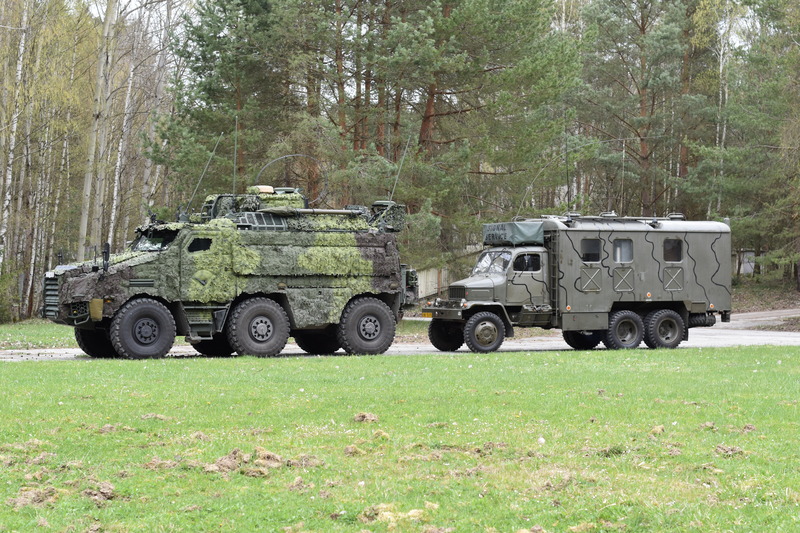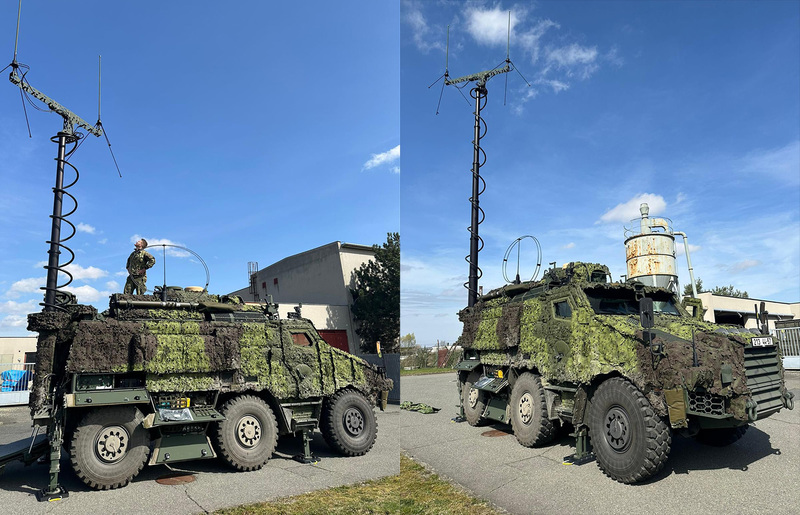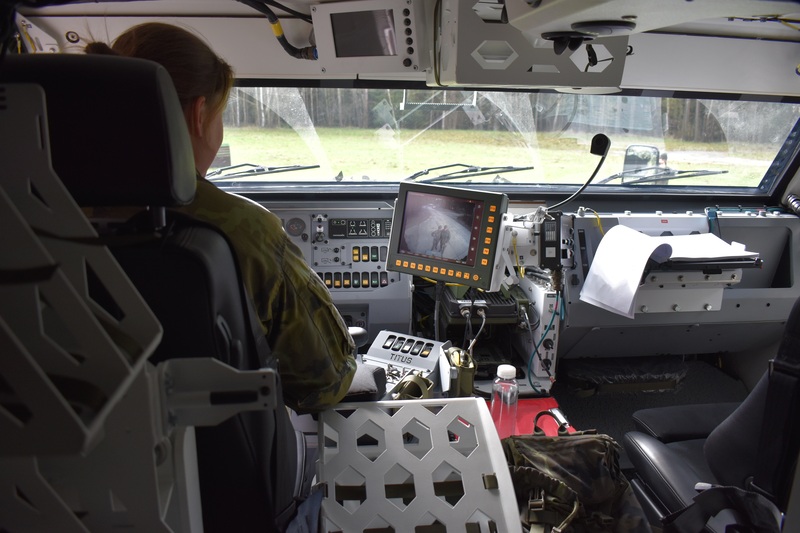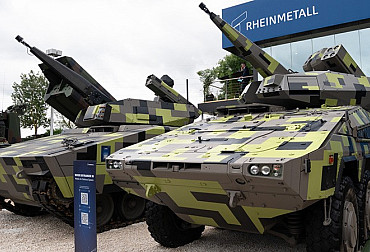New liaison vehicle opens another door for NATO alliance cooperation
Faster communication and safer operation - these are the two main advantages of the new KOVS (wheeled armoured vehicle) on the TITUS 6x6 chassis, which will replace its older predecessors in the engineer units.
KOVS is part of the command and control system, where this vehicle not only in the 15th Engineer Regiment will enable communication between the superior and subordinate unit at the level of modern technologies of the 21st century. The entire vehicle is built on L3Harris technology and the crew consists of 4 soldiers. The main difference from older types of communications vehicles is that everything is fully digitized with encryption capability. "The artillery regiment has older R6p radios on PV3S chassis, equipped with Dicom and Rohde-Schwarz technologies. The R7M1p plants, which are based on Land Rover LRD-110 chassis, also operate on the same technologies," Major Jiří Mráz, Chief of the KIS Department of the 15th Engineer Regiment, specified the current communications equipment of the engineers.

However, as he added, the radios in question do not allow quality data transmissions, encrypted data and voice transmissions, and basically only short text messages can be sent. "The R7 plants are capable of sending information, but lack the proper compatibility with more modern types of plants built on Harris technology, which is what we need in this day and age when everything is geared towards fast transmission over data. The old traffic facilities allow primarily unencrypted voice traffic," said Major Frost.
The TITUS vehicle in the KOVS version, among other things, enhances the link capabilities by encrypting data and voice traffic, which is one of the most secure links today, according to NATO standards. "In older-style operations, the operator was reliant on voice communications, which required long periods of time in which they radiated into the electromagnetic spectrum, aiding detection by enemy radio electronic warfare. The enemy could easily lock on to the transmission, ascertain our position, and could jam and eavesdrop on us. By deploying a KOVS facility, information flows will be largely encrypted. If the enemy intercepts the information, he will not be able to decipher it," explained Lieutenant Petr Procházka, the commander of the communications platoon of the 151st Engineer Battalion's headquarters company, explaining the main advantages of digitizing the communications.

The ability to communicate in the international environment of allied units also plays an important role in the use of KOVS. "Based on the concept of Federated Mission Networking, which addresses the compatibility of the command and control system of NATO units, the KOVS can be fully used and deployed with coalition units," said the Chief of the KIS Department of the 15th Engineer Regiment.
Within the 15th Engineer Regiment, the equipment has been assigned to the 151st and 153rd Engineer Battalions, increasing the capability of the command and control system in support of brigade task forces.

TITUS vehicles in the Czech Armed Forces
The Ministry of Defence of the Czech Republic ordered a total of 62 TITUS armoured vehicles for the Czech Army in 2017, in three versions - 6 units in the command and staff version (KOVVŠ) with 6 staff stations, 36 units in the liaison version (KOVS) and 20 vehicles will serve as fire support coordination points (MKPP). The delivery of serial TITUS vehicles in all 3 variants is now underway (e.g. all vehicles in the MKPP version have already been delivered). The total value of the contract is CZK 6 billion. As these are really high quality vehicles with excellent capabilities, it is not excluded that the army will demand more TITUS vehicles in the future.
Video: First training of driver-instructors for the new TITUS 6x6 / CZ DEFENCE
General parameters of the TITUS 6x6 armoured vehicle
- MRAV (Multi-role Armored Vehicle) category
- Crew of 4 persons, number varies by vehicle type
- High ballistic protection (STANAG 3). Body welded from heavy armoured sheet metal, with armoured plates and windows on the outside, internal walls lined with composite materials (spall liner). Effective protection against infantry weapons, heavy machine guns and artillery ammunition fragments, mines and IEDs.
- TATRA T 815-7 Force chassis with central tube and independently suspended, air-sprung semi-axles with first and third axles steerable
- Air suspension system with the possibility of changing the vehicle ground clearance. Outer turning radius 13 m, climb rate 60%, side roll value 30%. Tactical tyres 16,00 R20 with central inflation system, which allows not only adjusting the tyre pressure for different surfaces, but also driving with tyre punctures
- Vehicle speed on paved roads up to 110 km/h with a range of up to 700 km
- Universal armament carrier – Remote controlled weapon stations with the ability to mount a 12.7 mm calibre machine gun or 40 mm calibre grenade launcher. Possibility of installing a remote-controlled turret with a 20 mm rapid-fire gun and a 7.62 mm machine gun. Possibility of mounting up to three light machine guns on the hatch at the three roof hatches. Firing is also possible with a gun located in the folding ramp. Other versions of the TITUS armoured personnel carrier allow for the function of weapon system carriers – anti-tank and anti-aircraft missiles or a mortar of 120 mm calibre
- Electronic and communication systems provide classified and unclassified radio communication and data link in VHF and UKV bands and also by satellite tactical communication (SATCOM), including the use of integrated cryptomodules
- The vehicle is equipped with the already proven STAR Light 3 SF protective jammer from the Czech company URC Systems spol. s r.o. The jammer protects against the current threats of radio remotely launched IEDs, including 4G and 5G mobile communication systems. The system is ready for connection of a dedicated anti-drone jamming module (MAD). Also new is liquid cooling to reduce the jammer's build volume. The jammer succeeded in military trials
- Power is provided by an alternator connected to the vehicle's engine when the vehicle is moved. In both stationary and autonomous modes, the engine is switched off and the electronic systems are powered either from batteries, mains or a generator
- The radios and necessary components in the new MKPP vehicles will be compatible with the equipment already in place in the Czech Army. The new titles will also allow the fitting of a Battlefield Identification Friend or Foe (BIFF) system that can recognise own-foreign units
- Protection of the crew from the effects of chemical, biological and nuclear weapons
 Picture: Armoured vehicle TITUS in the field | Michal Pivoňka / CZ DEFENCE
Picture: Armoured vehicle TITUS in the field | Michal Pivoňka / CZ DEFENCE





















